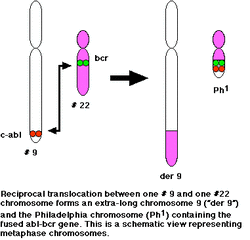|
|
Pathology definition - Chronic Myelogenous Leukemia

Chronic myelogenous leukemia
Laboratory investigation may reveal increase in the serum B12, decreased in leukocytes alkaline phosphate ( LAP ) and hyperuricemia. Blood film/peripheral blood smear may reveal leukocytosis and mature and immature granulocytes.
Chronic myelogenous leukemia is part of the myeloproliferative disorder which also consists of polycythemia vera, myelofibrosis and essential thrombocythemia. Chronic myelogenous leukemia’s patient may suffer from signs and symptoms such as enlargement of the spleen ( splenomegaly), fever, fatigue and night sweat). Chronic myelogeneous leukemia may transfer to acute leukemia ( blast crises ) which is lethal in nature and occur in 2- 5 years later after being diagnosed with chronic myelogenous leukemia.
Chronic myelogenous leukemia pathologically may present with infiltration of the granulocyte precursor cells in the bone marrow. Chronic myelogenous leukemia is commonly affecting middle age and elderly.
The treatment of chronic myelogenous leukemia include bone marrow transplantation or tyrosine kinase inhibitor ( imatinib) or hydroxyurea. Tyrosine kinase inhibitor ( imatinib) or hydroxyurea are chemotherapeutic agents.
Chronic myelogeneous leukemia is mostly due to formation of hybrid gene ( bcr- abl) which codes for protein with tyrosine kinase activity. This condition is associated with translocation between chromosome 9 and 22 or t( 9,22) which also known as Philadelphia chromosome.
References
1.Lozzio, C. B., and B. B. Lozzio. “Human Chronic Myelogenous Leukemia Cell-Line with Positive Philadelphia Chromosome.” Blood 45, no. 3 (March 1, 1975): 321–334.
2.Sawyers, Charles L. “Chronic Myeloid Leukemia.” New England Journal of Medicine 340, no. 17 (1999): 1330–1340. doi:10.1056/NEJM199904293401706.
Laboratory investigation may reveal increase in the serum B12, decreased in leukocytes alkaline phosphate ( LAP ) and hyperuricemia. Blood film/peripheral blood smear may reveal leukocytosis and mature and immature granulocytes.
Chronic myelogenous leukemia is part of the myeloproliferative disorder which also consists of polycythemia vera, myelofibrosis and essential thrombocythemia. Chronic myelogenous leukemia’s patient may suffer from signs and symptoms such as enlargement of the spleen ( splenomegaly), fever, fatigue and night sweat). Chronic myelogeneous leukemia may transfer to acute leukemia ( blast crises ) which is lethal in nature and occur in 2- 5 years later after being diagnosed with chronic myelogenous leukemia.
Chronic myelogenous leukemia pathologically may present with infiltration of the granulocyte precursor cells in the bone marrow. Chronic myelogenous leukemia is commonly affecting middle age and elderly.
The treatment of chronic myelogenous leukemia include bone marrow transplantation or tyrosine kinase inhibitor ( imatinib) or hydroxyurea. Tyrosine kinase inhibitor ( imatinib) or hydroxyurea are chemotherapeutic agents.
Chronic myelogeneous leukemia is mostly due to formation of hybrid gene ( bcr- abl) which codes for protein with tyrosine kinase activity. This condition is associated with translocation between chromosome 9 and 22 or t( 9,22) which also known as Philadelphia chromosome.
References
1.Lozzio, C. B., and B. B. Lozzio. “Human Chronic Myelogenous Leukemia Cell-Line with Positive Philadelphia Chromosome.” Blood 45, no. 3 (March 1, 1975): 321–334.
2.Sawyers, Charles L. “Chronic Myeloid Leukemia.” New England Journal of Medicine 340, no. 17 (1999): 1330–1340. doi:10.1056/NEJM199904293401706.
